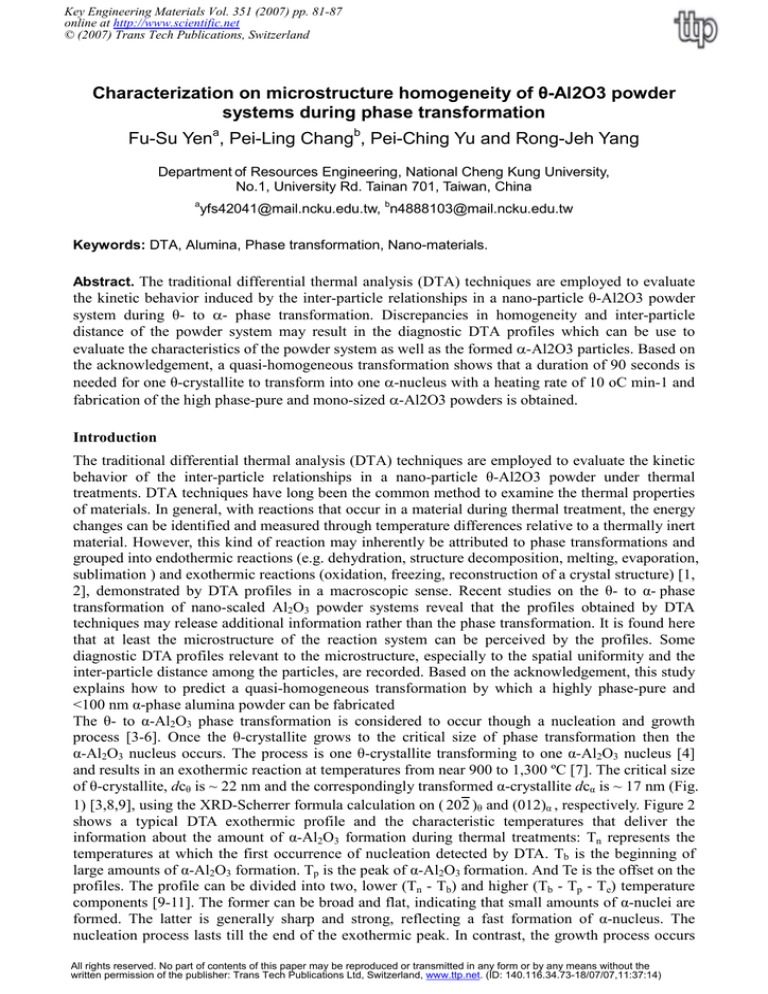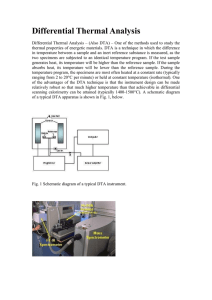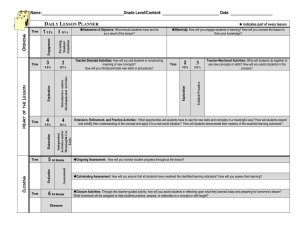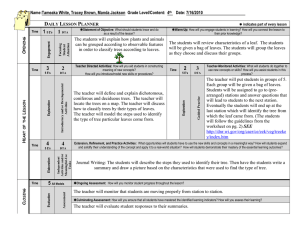
Key Engineering Materials Vol. 351 (2007) pp. 81-87
online at http://www.scientific.net
© (2007) Trans Tech Publications, Switzerland
Characterization on microstructure homogeneity of θ-Al2O3 powder
systems during phase transformation
Fu-Su Yena, Pei-Ling Changb, Pei-Ching Yu and Rong-Jeh Yang
Department of Resources Engineering, National Cheng Kung University,
No.1, University Rd. Tainan 701, Taiwan, China
a
yfs42041@mail.ncku.edu.tw, bn4888103@mail.ncku.edu.tw
Keywords: DTA, Alumina, Phase transformation, Nano-materials.
Abstract. The traditional differential thermal analysis (DTA) techniques are employed to evaluate
the kinetic behavior induced by the inter-particle relationships in a nano-particle θ-Al2O3 powder
system during θ- to α- phase transformation. Discrepancies in homogeneity and inter-particle
distance of the powder system may result in the diagnostic DTA profiles which can be use to
evaluate the characteristics of the powder system as well as the formed α-Al2O3 particles. Based on
the acknowledgement, a quasi-homogeneous transformation shows that a duration of 90 seconds is
needed for one θ-crystallite to transform into one α-nucleus with a heating rate of 10 oC min-1 and
fabrication of the high phase-pure and mono-sized α-Al2O3 powders is obtained.
Introduction
The traditional differential thermal analysis (DTA) techniques are employed to evaluate the kinetic
behavior of the inter-particle relationships in a nano-particle θ-Al2O3 powder under thermal
treatments. DTA techniques have long been the common method to examine the thermal properties
of materials. In general, with reactions that occur in a material during thermal treatment, the energy
changes can be identified and measured through temperature differences relative to a thermally inert
material. However, this kind of reaction may inherently be attributed to phase transformations and
grouped into endothermic reactions (e.g. dehydration, structure decomposition, melting, evaporation,
sublimation ) and exothermic reactions (oxidation, freezing, reconstruction of a crystal structure) [1,
2], demonstrated by DTA profiles in a macroscopic sense. Recent studies on the θ- to α- phase
transformation of nano-scaled Al2O3 powder systems reveal that the profiles obtained by DTA
techniques may release additional information rather than the phase transformation. It is found here
that at least the microstructure of the reaction system can be perceived by the profiles. Some
diagnostic DTA profiles relevant to the microstructure, especially to the spatial uniformity and the
inter-particle distance among the particles, are recorded. Based on the acknowledgement, this study
explains how to predict a quasi-homogeneous transformation by which a highly phase-pure and
<100 nm α-phase alumina powder can be fabricated
The θ- to α-Al2O3 phase transformation is considered to occur though a nucleation and growth
process [3-6]. Once the θ-crystallite grows to the critical size of phase transformation then the
α-Al2O3 nucleus occurs. The process is one θ-crystallite transforming to one α-Al2O3 nucleus [4]
and results in an exothermic reaction at temperatures from near 900 to 1,300 ºC [7]. The critical size
of θ-crystallite, dcθ is ~ 22 nm and the correspondingly transformed α-crystallite dcα is ~ 17 nm (Fig.
1) [3,8,9], using the XRD-Scherrer formula calculation on ( 202 )θ and (012)α , respectively. Figure 2
shows a typical DTA exothermic profile and the characteristic temperatures that deliver the
information about the amount of α-Al2O3 formation during thermal treatments: Tn represents the
temperatures at which the first occurrence of nucleation detected by DTA. Tb is the beginning of
large amounts of α-Al2O3 formation. Tp is the peak of α-Al2O3 formation. And Te is the offset on the
profiles. The profile can be divided into two, lower (Tn - Tb) and higher (Tb - Tp - Te) temperature
components [9-11]. The former can be broad and flat, indicating that small amounts of α-nuclei are
formed. The latter is generally sharp and strong, reflecting a fast formation of α-nucleus. The
nucleation process lasts till the end of the exothermic peak. In contrast, the growth process occurs
All rights reserved. No part of contents of this paper may be reproduced or transmitted in any form or by any means without the
written permission of the publisher: Trans Tech Publications Ltd, Switzerland, www.ttp.net. (ID: 140.116.34.73-18/07/07,11:37:14)
82
Composite Materials V
mainly in latter component, although it can start prior to the starting of latter component.
Fig. 1 TEM micrographs of crystallite size dcα, dp and ds of α-Al2O3. (a) The critical crystallite size
dcα and primary crystallite size dp with corresponding ED pattern, (b) minimum stable crystallite
size ds.
Fig. 2 Schematic depiction of typical DTA
exothermic profile and characteristic
temperatures of θ- to α-Al2O3 phase
transformation, where Tn : onset temperature,
Tb : amplified initial temperature, Tp : peak
temperature, Te : offset temperature.
Methods.Table 1 lists the basic properties of the starting θ-Al2O3 powder cited in this study. The
references cited in the texts also listed in the remark.
Table 1 Basic properties of the starting θ-Al2O3 powders.
Sample of Ref.
Crystallite diameter (nm)*
Chang [10]
22, 25
Yen [8, 9]
11.3, 17.7, 21.8
Yen [13], Yu [11]
12.57, 18.45, 21.68
Yu [12]
11, 20
* XRD-Scherrer formula on (012) and ( 202 ) of α- and θ-phase Al2O3
** α phase < 2.4 wt %, ~ 46 nm
Phase
θ (δ), θ α**
θ (δ), θ (δ), θ (δ)
θ (δ), θ (δ), θ (δ)
θ (δ), θ (δ)
All samples were characterized as described previously. DTA profiles were recorded with heating
rates of 10 and 15oC.min-1. XRD-Scherrer formula calculation was employed for crystallite size
measurements. High resolution transmission electron microscopy techniques were applied for
micro-structure investigation.
Key Engineering Materials Vol. 351
83
Results and Discussion
The presence of the former temperature component as well as a wider exothermic temperature range
of the DTA profile must result from an inhomogeneous nucleation process. Because the
θ-crystallites in the powder system cannot reach the size dcθ simultaneously, the sequential
appearance of exothermic peaks at different temperatures reflects various amounts of α-nucleus
formation at the temperatures [3,9,10]. Furthermore, the earlier formed α-crystallites may hinder the
migration of θ-particle, making it necessary for the dcθ size to be attained at higher temperatures. In
this case the sample may experience unfinished θ- to α-Al2O3 phase transformation on running DTA,
because with several subsequent measurements of DTA, the Tp peak would always re-appear (Fig. 3)
accompanied with residual θ-crystallites in the sample [10]. These phenomena can be verified by
addition of α-crystallites to the θ-powder system (Fig. 4) [11]. Applying an appropriate
homogenization step will convert θ-powder systems to show only one Tp peak. Simply mixing two
powder systems will show that there are two neighboring peaks on the DTA profiles (Fig. 5). Then
after a homogenizing procedure, the two peaks will combine into one. Moreover, the lower
temperature component of DTA profiles may disappear as well [12]. The peak temperature can be
reduced if the distance among the θ-crystallites in the powder is brought closer (Fig.6) [3, 13].
Laboratory examinations with θ-powder compacts of various bulk densities revealed that the lowest
peak temperature of a θ- powder compact can be ~ 1,050 oC [13]. A duration of 90 seconds was
concluded for the transformation of one θ-crystallite to one α-nucleus with a heating rate of 10
o
C.min-1 is employed [13].
Fig. 3 Typical DTA profiles show an inevitable presence of residual θ-Al2O3 crystallites in α-Al2O3
powders. (a) Inhomogeneous spatial distribution of θ-crystallite may result in multi-peak profiles.
Hearing rate: 10 oC.min-1. (b) The Tp peak would always re-appear due to unfinished θ- to α-Al2O3
phase transformation. Heating rate: 15 oC.min-1 [10].
84
Composite Materials V
Fig. 4 DTA profile variations during θ- to α-phase
transformation of 4 θ-powder systems due to external
additions of α- Al2O3 particles, (a) 0, (b) 10, (c) 30, and (d)
44 wt % [11].
Fig. 5 DTA profiles of (θ + θ)-Al2O3 composite powder
systems. Two starting powders (a) and (b) with
different crystallite sizes of 20 and 11 nm, respectively,
and mixing for 30 sec (c), 2 min (d) and 6 min (e).
Mixing ratio of 1:1 [12].
Thus it is noteworthy that the DTA profile behaved by θ → α- phase transformation of nano-scaled
Al2O3 particles reflects some basic characters of the powder system, except for the occurrence of
phase transformation as generally described in text books. Additional information related to the
transformation of the powder system includes: 1) the phenomena of mass transfer among the
particles of the initial θ-crystallites and that of the interaction between the two phases; 2) the spatial
homogeneity, the state of agglomeration, the size distribution of the powder system; and 3) the
packing density or the distance among the particles can be well-released. Figure 7 shows the DTA
profile of a well-homogenized θ-Al2O3 powder system. It is clear that it is a monotonic exothermic
peak. Figure 8 demonstrates the TEM micrograph and the particle size distribution of the α-Al2O3
powder obtained by calcination of the θ-Al2O3 powder.
Key Engineering Materials Vol. 351
85
Fig. 6 DTA profiles show that bringing θ-crystallites closer may decrease Tp temperatures.
Uniaxially pressed powder compacts of three θ-powder systems with mean particle sizes
(XRD-Scherrer formula) (a) 11.3 (sample S), (b) 17.7 (sample M), and (c) 21.8 (sample L) nm. The
pressures employed were 245 (2), 500 (5), and 755(7) MPa. (0) was the samples as-received. Peak
temperature reductions on DTA curves were summarized in (d). The heating rate was 10 oC.min-1
[13].
Fig. 7 DTA profile of a well-homogenized
θ-Al2O3 powder system, showing a monotonic
exothermic peak [14].
86
Composite Materials V
Fig. 8 TEM micrographs and the particle size distribution of the α-Al2O3 powder obtained
by calcinations of the θ-Al2O3 powder [14].
Summary
Except for the occurrence of phase transformation as generally described in text books, the DTA
profile behaved by θ → α- phase transformation of nano-scaled Al2O3 particles reflects some basic
characters of the powder system, including: 1) The phenomena of mass transfer among the
θ-crystallites and the followed interaction. 2) The spatial homogeneity, the state of agglomeration,
the size distribution of the powder system, and 3) The packing density or the distance among the
particles. Thus a monotonic exothermic peak with narrower peak width can be a pre-requirement
for fabrication of a highly phase-pure and <100 nm α-phase alumina powder.
Acknowledgement
This work was supported by the National Science Council under Contract No.
92-2219-E006-027.
References
[1] W. Smykatz-Kloss: Differential Thermal Analysis Application and Results in Mineralogy
(Springer-Verlag, New York 1974).
[2] R.F. Speyer: Thermal Analysis of Materials (Marcal Dekker, Inc. New York 1994).
[3] F.S. Yen, J.L. Chang and P.C. Yu : J. Cryst. Growth Vol. 246 (2002), p. 90
[4] H.L. Wen, Y.Y. Chen, F.S. Yen and C.Y. Huang: NanoStructured Materials Vol. 11 (1999), p.
89
[5] F.W. Dynys and W. Halloran: J. Am. Ceram. Soc. Vol. 65 (1982), p.442
[6] T.C. Chou and T.G. Nieh: J. Am. Ceram. Soc. Vol. 74 (1991), p. 2270
[7] K. Wefers and G.M. Bell: Oxides and Hydroxides of Aluminum (Tech. Paper No. 19, Alcoa
Research Laboratories, 1972).
[8] H.L. Wen and F.S. Yen: J. Cryst. Growth Vol. 208 (2000), p. 696
[9] F.S. Yen, H.L. Wen and Y.C. Hsu: J. Crystal Growth Vol. 233 (2001), p. 761
[10] P.L. Chang, F.S. Yen, K.C. Cheng and H.L. Wen: NanoLetters Vol. 1 (2001), p. 253
[11] P.C. Yu, F.S. Yen and T.C. Lin: J. Crystal Growth Vol. 265 (2004), p. 137
[12] P.C. Yu and F.S. Yen: Key Engineering Materials Vol. 249 (2003), p. 175
Key Engineering Materials Vol. 351
87
[13] F. S. Yen, M. Y. Wang, and J. L. Chang: J. Cryst. Growth Vol. 236 (2002), p. 197
[14] P.C. Yu, Y.T. Chang and F.S. Yen: 3rd IUPAC-sponsored International Symposium on Macroand Supramolecular Architectures and Materials (MAM-06), (2006).





